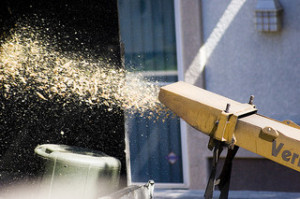
Photo credit: Watchcaddy on Flickr. Note: the woodchipper in this photo is not known to be involved in any incidents.
Potential hazards. Preventive measures. Which ones are most important for people who work outside?
Readers of the April 2013 issue of Insight Magazine – an electronic newsletter published by the Regulation and Policy Division of WorkSafeBC – were asked to share their thoughts. A prize-draw would be held at the end.
This form of idea-gathering is one of the best things about the Internet. People have so much knowledge and creativity, and it’s interesting to see what they come up with.
I was curious to find out more so I got in touch with Lesley, the WorkSafeBC research analyst who collected the responses. I asked why it’s valuable for an organization like WorkSafeBC to get information in this way and she said it’s a good way to engage readers in health and safety discussions & get them thinking about health and safety in their workplaces.
She said it gives the organization a chance to get insight from readers about issues they encounter at work and enables readers to share information with each other through the answers published in Insight.
“It’s a good way to make health and safety relevant and engaging through friendly competitions,” said Lesley, who sent a sample of suggestions received. Here’s a few:
Risk of wasp and bee stings
To minimize risks: Ask each employee during orientation if they have an allergy and ensure first aid attendants are aware of anyone with this medical condition.
Staff with such allergies can fill out a copy of the Staff Medical Information Form on Page 25 of the Health and Safety Guide for Garden Centre Workers produced by the BC Garden Centre Retailers. It includes space to tell the employer if they use an epipen (to prevent serious allergic reaction).
Protecting yourself from stinging insects – from NIOSH
Risk of falling in fast moving water
To minimize risk: have a crew talk to discuss staying away from the edge of fast moving water.
Cold Water Immersion reminds workers to:
- Always wear a PFD, life jacket, or immersion suit when working on or near water (wherever there is a risk of drowning).
- Ensure that the equipment used for a specific procedure has been designed to perform that procedure.
- Make sure you have an effective means to call for help when working in remote locations.
- Use fall-arrest equipment when working on bridges or over the side of vessels.
Risk of inhaling dust and pollen
To minimize risk: Use PPE’s such as respirators/masks/goggles when working in dusty conditions (or with grasses, dirts, etc.) to assist with lessening the symptoms.
Choose the right PPE for the job – with help from the Personal Protective Equipment (PPE) info sheets that inform employers, supervisors, and workers of what’s required by regulation for specific industries and hazards.
Dangers of working with wood chippers for tree trimmings
To minimize risk, ensure safeguards on the chipper are in place and used. Watch this slideshow from WorkSafeBC Worker pulled through woodchipper
Who won?
Shannon from PLEA Community Services Society of BC was drawn as winner, according the May issue of Insight. She’ll receive a WorkSafeBC auto safety kit. Congrats
Thanks to all who shared ideas – and to Lesley for sharing them with me. Do you have any summer safety tips to share?


